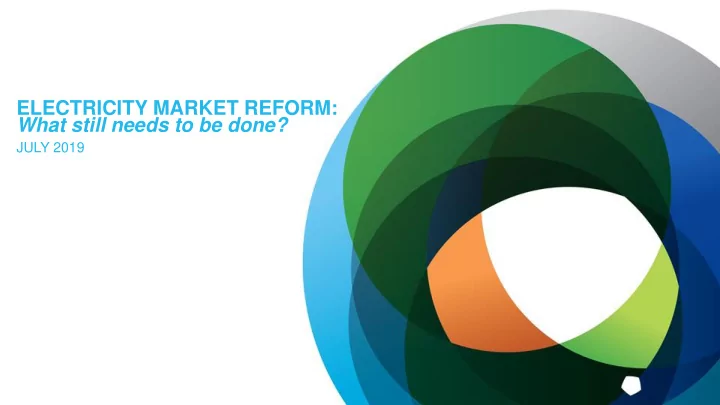

ELECTRICITY MARKET REFORM: What still needs to be done? JULY 2019
WHERE EXACTLY ARE WE AND HOW DID WE GET HERE? Electricity sector emissions were rising – pricing the externality and leaving markets to resolve the issue has proven politically too difficult 2
WHERE EXACTLY ARE WE AND HOW DID WE GET HERE? Source: ABS 6401.0 Consumer Price Index, Australia Unsustainable growth in retail prices coupled with poor customer experience has led to further interventions 3
WHERE EXACTLY ARE WE AND HOW DID WE GET HERE? Directions and interventions by AEMO are now necessary to keep the system secure but distort market price signals 4
WHERE EXACTLY ARE WE AND HOW DID WE GET HERE? The level of market distortion and the pace of transition raises questions about the ability of the existing market design to deliver adequate level/mix of generation investment 5
CENTRALISED ELECTRICITY SYSTEM – CURRENT/EVOLVING MARKET DESIGN 6
CENTRALISED ELECTRICITY SYSTEM – CHALLENGES TO MEET Accelerated closure reflects pressure from renewable build and coal costs. Timing to reflect avoiding major overhauls Potentially rapid exit of existing plant due to: carbon Lowest risk investments in short-term asynchronous constraint; aging infrastructure; reduction in cost and variable in output and not able to deliver full suite curves of new technologies; consumer preferences; of system security services and in new locations and lack of flexibility in existing fleet without strong existing connections to the network 7
CENTRALISED ELECTRICITY SYSTEM – CHALLENGES TO MEET In addition to policy and demand risk, technology risk complicates investment decisions 8
CENTRALISED ELECTRICITY SYSTEM – KEY QUESTIONS • Will the current, evolving market design be capable of meeting these challenges and: ➢ deliver smooth exit of existing generation capacity and deliver sufficient new investment to reliably meet future demand for energy and capacity without the need for government intervention? ➢ provide the right signals for the efficient provision of the full range of system security services required to keep the system secure – frequency, inertia, system strength, voltage, black start etc? ➢ deliver least-cost generation for customers? • Are there better ways to provide more efficient locational signals for new investment in generation and transmission? • Who should pay for transmission and what should they get for it? 9
KEY RISKS THAT COULD PREVENT CURRENT MARKET DESIGN FOR CENTRALISED ELECTRICITY FROM MEETING FUTURE CHALLENGES Lack of longer-term Affordability Price volatility price signals Lack of confidence Inefficient risk Unexpected in/visibility of allocation closure physical resources Lack of (financially) Inefficient Inadequate system firm access for locational signals security services generators to for new investment network 10
DISTRIBUTED ENERGY SYSTEM 11
DISTRIBUTED ENERGY SYSTEM – CHALLENGES TO MEET Policy and regulatory frameworks for the distributed energy system are struggling to keep pace with the scale of consumer adoption 12
DISTRIBUTED ENERGY SYSTEM – KEY QUESTIONS • What changes are required to policy and regulatory frameworks to support DNSPs’ role as efficient platforms for energy services? • Are sufficient incentives and regulatory arrangements in place to drive innovation in the supply of distribution services and for distributors to use services from DER to minimise their costs? • What is the best way for DNSPs to send signals to consumers (or their agents/intermediaries) about the relative system value of their imports and exports at different times and places? • How do we maximise the opportunities for customers to take-up service options that meet both their needs and the needs of the system? • How do we ensure regulatory frameworks do not prevent innovation but also do not bias against grid-based services? • How do we enable business models that take the complexity of the emerging grid - a system of 2-way flows and potentially more dynamic and granular pricing signals - and turn this into simple customer value propositions without completely dissipating the signals? 13
KEY RISKS THAT COULD PREVENT CURRENT MARKET DESIGN FOR DISTRIBUTED ENERGY SYSTEM FROM MEETING FUTURE CHALLENGES Lack of price signals to retailers, Affordability Capex bias intermediaries and customers Split incentives Lack of Ineffective consumer between DNSPs and visibility/control of protections retailer/intermediaries physical resources Regulatory inertia that stifles innovation 14
15
Recommend
More recommend